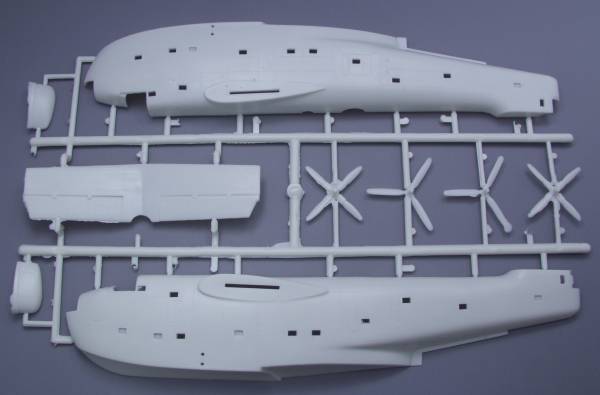

PB2Y-5

The Kit

Mach 2 kits have a mostly bad reputation as being some of the worst short run kits on the market, usually displaying sink marks on the wings and fuselage, huge ejector pin stubs on the inner surfaces, rough surface texture, terrible clear parts and flash every where. This kit seems to be one of Mach 2's better attempts. While the surface still has some roughness and irregularities there were no sink marks that I could see and the engraved panel lines seemed to be uniform and didn't disappear as on some of their other kits. Still lots of ejector stubs and the small parts are still flash laden and the clear parts could be better. Little in the way of interior detail is provided, a bulkhead, floor, seats and control columns. The box doesn't state what version the kit is and the instructions are labeled PB2Y-2, however a -2 two it isn't. The -2 lacked the turrets, had totally different beam positions, had a large blister on the top where the dorsal turret is located, did not use the radar housing above and behind the cockpit and didn't have the four-bladed props on the inboard engines. The kit can best be used to represent a -5. The -3 could be done by replacing the inboard propellers with three bladed units.
Lets take a look at what's in the box. There are five sprues of white plastic. Two sprues are nearly identical with bottom wing halves and various other parts, another nearly identical pair have upper wing halves and various other parts and a third has the fuselage and various other parts. Total parts count 87. See below...



There is one sprue with clear parts if you can call them that, typical of most Mach 2 kits. Future may help them some. Unfortunately there are no after market vacuformed replacements available. Parts count 32 for a total of 119 in the box. See below...

The decal sheet has the markings for the aircraft shown on the box top. The painting instructions show the colors and markings for an RAF aircraft but notes that roundels and fin flashes are not included. Other than the Star and Bar and the aircraft number the only other markings supplied are the manufacturers decals for the props. The decals look OK but I have no experience with Mach 2 decals so I can't comment on them. The color has been adjusted to make the lettering visible. See below...

The instruction sheet consists of a single A4 size page with various sub assemblies shown on one side and painting and lettering shown on the other. There are only a couple written notes on the assembly side which indicates where most of the small parts go but nothing showing the fuselage, wing or wing to fuselage assembly so you are pretty much on your own. The kit does come with beaching gear.
Conclusions
I test fitted the fuselage halves just out of curiosity. While they seem to match up pretty well, assembling them will be a challenge. One half has a bulge in the bottom of the fuselage just past the step that may be tough to fix and it looks like some addition bulkheads would be helpful to maintain the fuselage shape while gluing. As with all the kits from Mach 2 much labor is required to clean up flash from small parts and the lack of alignment pins makes assembly challenging. I would recommend the kit only to die hard seaplane fans and those with multiple limited run kit experience.
Links to kit build or reviews
References





Last updated 5/10/08